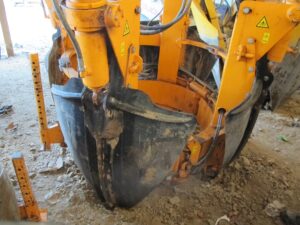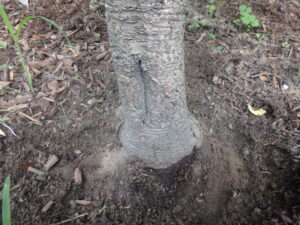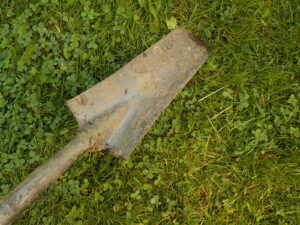How to Move a Shrub
Posted on Tuesday, July 12, 2022 · Leave a Comment

A tree spade can move good-sized tree, but it is expensive to do so
I remember talking to a gardener some years ago who, when I mentioned that her tall pines were interrupting the view, waved a hand and said, dismissively, “Oh, yes, I’ll have someone move them.” I nearly choked. Moving shrubs is not difficult, but big trees? Though theoretically possible using a big machine called a tree spade, it’s a very expensive proposition.
I have moved several shrubs over the years. I bought a Carolina allspice or sweetshrub (Calycanthus floridus) which, according to the literature, can be planted in full sun or part shade. I planted it in full sun in rich, moist soil. The first year the leaves got sun burned and developed brown edges. Oh well, I thought, perhaps it had been grown in deep shade. If so, it will recover and next year it will be fine. But the next year it burned again.
So that fall I moved my shrub to a shady place which got just a little dappled sunshine. It did not burn, but it didn’t flower much the year or the year after. “Huh”, I thought. “Maybe it needs more sun”. I waited a few more years, and never got many blossoms.
Finally, like Goldilocks of Three Bears fame, I found just the right place. I moved it into dappled shade under a big pear tree. It has flowered magnificently ever since. Which shows, I suppose, the persistence is important in the gardening world. I was tempted to let it just muddle along, but was rewarded for my effort moving it.

Moving a shrub is hard work but possible
It is much easier to move a shrub in the first year or two of its life in your garden. It takes a few years for roots to grow out and away from the root ball. Early in its life in your garden you will be able to see its original rootball when you dig it out.
When I plant a tree or shrub I generally facilitate root expansion in two ways. First, I dig a wide hole for the root ball – at least three times as wide as the root ball. If the soil is very compacted, I dig an even wider hole. All that digging is intended to leave the soil fluffier, and easier for tiny roots to penetrate.
Secondly, I loosen the roots, tugging them away from the root ball. I pull away any encircling roots. I use my CobraHead weeder to tug on bigger roots that are firmly tangled to get them loose and ready to spread out into the soil. And if I break some smaller roots? I don’t worry. It will stimulate the roots to grow.
The hole should only be as deep as the root ball, not deeper. Your tree should sit on un-excavated soil so that it will not settle in time. If soil or mulch covers the trunk flare, the trunk will rot. It is a slow process, but soil and bark mulch have fungi that will destroy the bark of a tree, slowly killing it – it takes six to ten years.

Trunk flare should never be covered with soil or bark
What is the trunk flare? That is the area at the base of the tree that flares out and often sends out above-ground roots that gently descend into the soil. It is most obvious in large trees, but some swelling in small trees should be evident at the base of the tree. That area is often buried with soil when you buy a tree, and you need to expose it.
If the flare is buried after planting, you may notice tip die-back at the top of the tree, and early fall coloring. Both are signs of trouble. Check out trees you have planted – and pull back the mulch or soil that is covering the flare. Do it now, and your tree may recover (depending on how long the flare has been buried).
If you are planting trees this summer, remove the tree from its pot or burlap covering. Expose the trunk flare before you dig the hole so you will know how deep to dig. I put a rake handle or wood stake over the hole to help me measure how deep it is before placing the tree into the hole. It is better to have the hole a little shallow than a little too deep. You can always mound the soil to bring it up to the proper amount of coverage.

This drain spade is good for transplanting perennials and shrubs
For moving shrubs, the best tool to use is a long narrow shovel called a drain spade. The blade on mine is about 6 inches wide and 15 inches long. I push the blade into the soil in four places around the shrub. Each time the blade goes into the soil on about a 45 degree angle, with the idea of getting under the center of the shrub itself. I push down on the handle, and it lifts the shrub a little. After loosening the shrub I push down hard on the shovel and the shrub is ready to lift out.
The best time to move a shrub is in the afternoon of a drizzly or cloudy day, not on a hot, sunny day. Move the shrub right into a prepared hole at its new home. I generally do not add fertilizer to the new hole as I don’t want to force rapid new growth. Slow-release organic fertilizer is safe to use, but not too much, and a little compost is good, too.
Be sure to press the shrub down firmly in the hole after you have filled in the space around the root ball with soil, and to pack the soil in around it firmly with your hands. Water well at planting time, and at least every other day during hot, sunny times.
Lastly, I recommend looking at where other people have planted shrubs of the same species as yours that are doing better. And if you need to move yours to a better location? Go for it!






